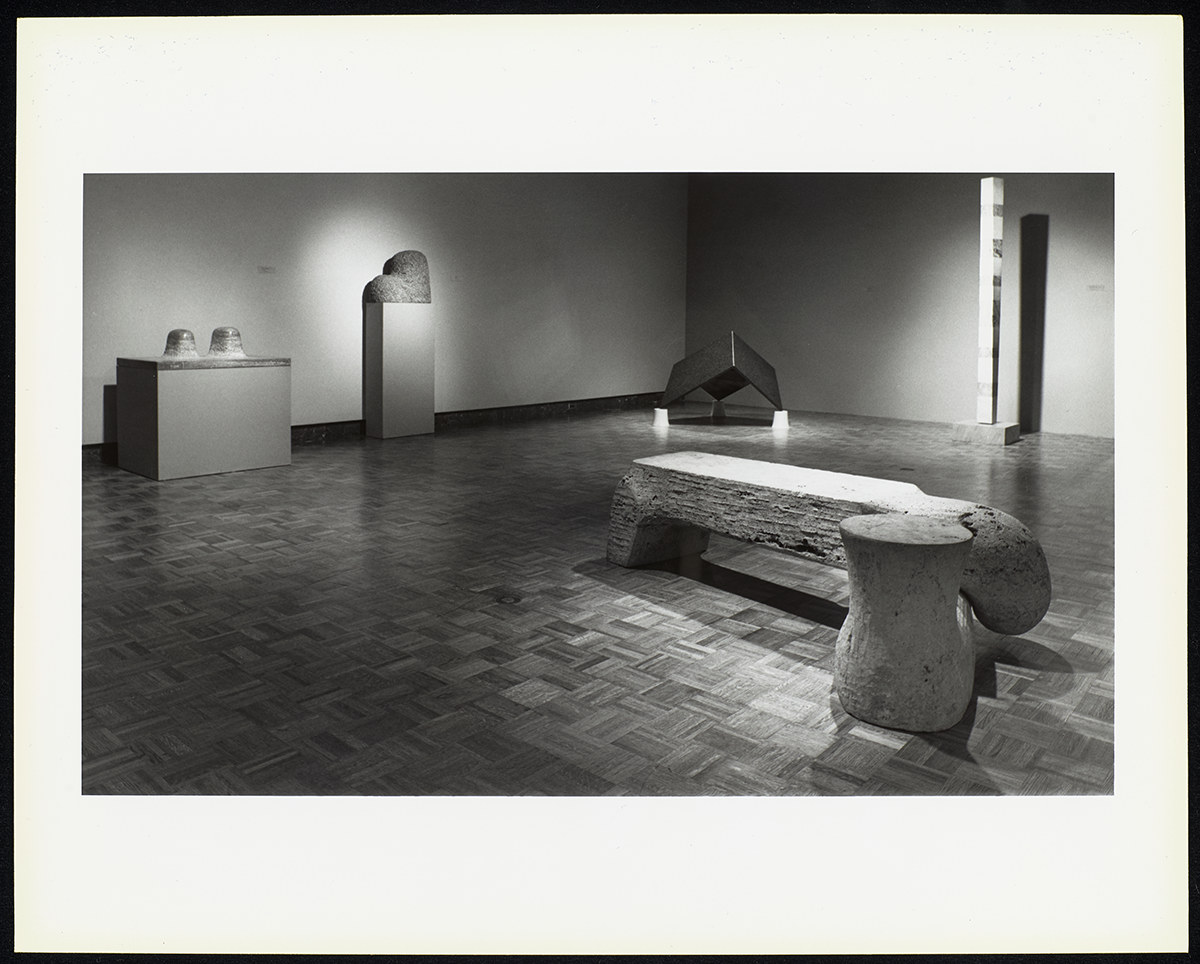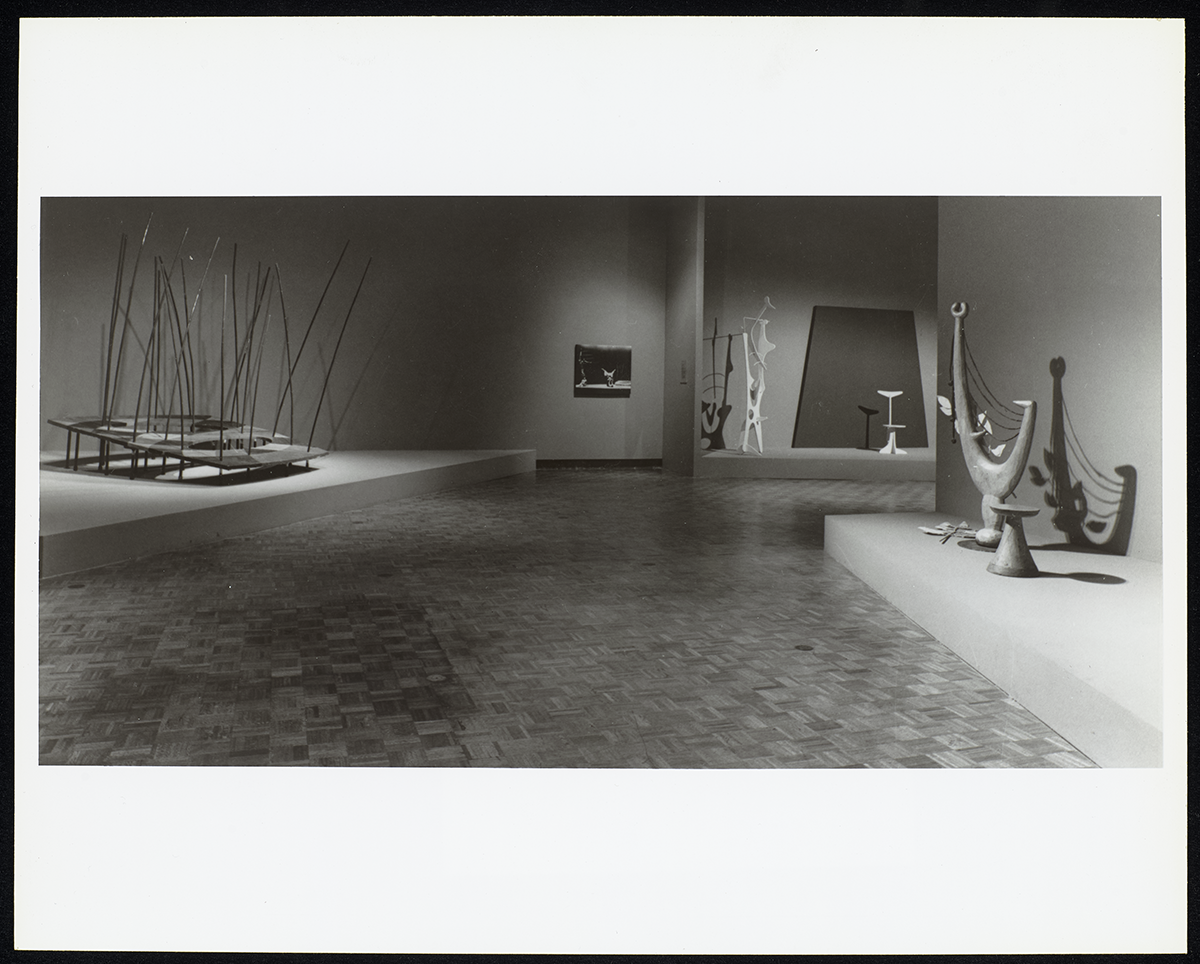The Little-Known Public Spaces of Isamu Noguchi: HART PLAZA
WORDS by ALEXANDRA KIRBY COURTESY of DOCOMOMO US | PHOTOGRAPHY by THE NOGUCHI MUSEUM
While Japanese-American sculptor Isamu Noguchi (1904–1988) is well known for his abstract sculptural work, much of which is housed at the Isamu Noguchi Museum, his spatial designs have largely been forgotten, either due to never coming to fruition or because a majority are hidden behind private gates. Noguchi’s imaginative spaces vary from playgrounds to suburban corporate courtyards, such as the Connecticut General Life Insurance Company (now CIGNA) campus in Bloomfield, CT. His early spatial designs included a handful of unrealized commissions for the City of New York (many plans are cast in bronze at the museum), and numerous East Coast projects with SOM architect Gordon Bunshaft including the sunken gardens at Chase Manhattan Plaza and Yale’s Beineke Library.
Late in his career, from 1978 until his death in 1988, Noguchi designed four public spaces in the United States: Philip A. Hart Plaza in Detroit, Michigan (1978); the Japanese American Cultural and Community Center Plaza in Los Angeles, California (1980); Bayfront Park in Miami, Florida (1986); and the privately managed California Scenario in Costa Mesa, California (1981). These sites are Noguchi’s only publicly accessible spaces, as well as his most endangered.
Philip Hart Plaza (1972–1978), his earliest and most impressive public commission, is located in Detroit’s downtown, on the river looking south to Windsor, Canada. It is the quiet civic center of a city that has become an icon of post-industrial urban decay. The eight-acre plaza, originally conceived as the locale for Detroit’s civic events, is situated at the southern edge of the city’s radial street plan, elevated above the edge of the Detroit River with the UAW- Ford National Programs Center (previously the Veterans Memorial Building) and Cobo Convention Center to the west. To the north, Jefferson Avenue separates the plaza from the high rises of Detroit’s Financial District, creating a backdrop of architectural styles. To the east, one can see the vacant footprint of the former Ford Auditorium, demolished in 2011, and the General Motors Renaissance Center.
Following critical acclaim of his dramatic Osaka Fountains at Expo ’70 in Osaka, Japan, Noguchi was commissioned by the city of Detroit to design a $2-million fountain in honor of American automotive innovator, Horace E. Dodge, Sr., and his son. Before long, Noguchi was consulting the firm of Smith, Hynchman & Grylls on the design of the entire plaza. The two-level plaza is paved in carnelian granite and centers on Noguchi’s impressive Dodge Fountain, a polished steel behemoth shaped like an upturned wing nut. The fountain was originally programed to perform a series of thirty-three patterns of spray from its 300 water jets, offering a visual spectacle for the city where children could play on hot summer days.
Noguchi was very involved with every detail of his plaza design, most notable in the computer programming for the fountain jets and the finishes of steel and granite installations. Inviting pedestrians to the space, a twisted pylon rises 120-feet into the air at the base of downtown’s radial plan. The plaza features playful topography, including a massive ziggurat at the eastern edge that overlooks a subterranean amphitheater, surprising circular dips in the main plaza, and an underground concession level that is accessed by a broad arc of shallow stairs.
Since its opening in 1978, the plaza has seen the addition of lighting (which Noguchi adamantly opposed), security cameras, cell phone antennas, and the 2003 monument, Transcending: The Legacy of the Labor Movement, all of which have severely detracted from Noguchi’s original design. Alicia Minter, Director of the City of Detroit Recreation Department, explained that there are conceptual plans to change the physical design of the Hart Plaza and create more green open space to transition to the riverfront. She writes that, “it is a hard surface plaza with small amounts of green space. It requires a tremendous amount of capital for ADA compliance and general improvements.”
While these tentative plans are not currently available, it is hard to believe that a new lawn would complement Noguchi’s design– which only included sparse groves of trees at the plaza’s perimeter– not to mention survive the harsh Midwestern winters. Green landscaping is also hardly ideal for the volume of traffic generated by events such as the hugely popular Movement Electronic Music Festival, which takes place over the course of a week early in the summer, with over 100,000 visitors to the plaza. Noguchi’s granite paving, on the other hand, has survived over three decades in shockingly good condition.
In 2012, AIA Detroit’s Urban Priorities Committee held its annual international “Detroit by Design” competition, focusing on the city’s waterfront. The objective was: Amazing and Connected, emphasizing the need for physical, visual and historic connectivity and new ideas, but the literature for competitors lacked contextual background for thoughtful and transformative design, and adequate reference to the value of the Noguchi design. The competition received 174 entries from architectural firms and artists across the globe proposing creative, although rarely rational, approaches to how to reactivate the urban edge of Detroit. Winning submissions were selected by a jury comprised of the architect Daniel Libeskind, the landscape architect Walter Hood, Cranbrook Academy of Art and Museum Director Reed Kroloff, Detroit Riverfront Conservancy President Faye Alexander Nelson, and the Toronto-based architect Lola Sheppard.
Of the six winning entries, only one was from the United States – by Atelier WHY. The proposed designs were largely exercises in creative thinking to offer innovative approaches to the longstanding issues surrounding the waterfront and broader issues of Detroit as a whole, and were clearly not founded in experience or under- standing of the existing site but, rather, as a stage for radical design.
This competition showed the growing international recognition of Detroit’s urban planning challenges, but aimed for a carte blanche approach rather than embracing the distinctive extant resources on the waterfront, such as Hart Plaza.
At a mere 34-years-old, Hart Plaza is already perceived as a relic of our past. When constructed, the plaza was hailed as a cultural landmark that helped to fortify a new post-war identity for the city of Detroit. It was designed primarily as a congregational space to act as the heart of the city’s civic activity, while allowing down- town workers a space to relax during the week, demonstrating Noguchi’s interest in the themes of leisure and ritual. Initially commissioned with pride and opened with great ceremony, today the plaza is severely underused and simply derelict, but above that it remains one of Noguchi’s largest and most unusual works in his diverse oeuvre.
Modernist civic spaces have been subject to a great deal of scrutiny–and demolition–in the past years. San Francisco’s UN Plaza (Lawrence Halprin, 1975) and Boston City Hall (Kallman, McKinnell and Knowles, 1968) have been listed as some of the “World’s Worst Public Spaces” by the Project for Public Space, and we’ve seen the recent demolition of Dan Kiley’s Lincoln Center Plaza North design in New York City (1964, demolished 2009) and partial demolition of Lawrence Halprin’s Skyline Park (1978, remodeled 2003) in Denver, Colorado. While it can’t be denied that change is inherent in architecture and landscape, and that the needs of a community should be the primary concern in a public space, demolition can’t always be the answer. What so many of these sites lack are substantial activation, education and above all, general maintenance.
Nevertheless, there are few civic spaces that came out of the urban renewal period of the mid-1970s through 1980s that are equal in artistic value to the Noguchi sites; most were works of experimental planners and landscape architects who approached public design and the urban experience from a very different perspective than Noguchi’s. Philip Hart Plaza is an Noguchi designed many public sculptures, and as recognized works of art, they will be protected for future generations to enjoy. His public spaces, on the other hand, are largely understood as landscapes rather than as art pieces. This makes Noguchi’s public spaces difficult to assertively categorize and, more importantly, to safeguard. Unfortunately, because of their perception as public spaces rather than individual artistic works, they require a much broader and complex understanding of the artist’s intention than do traditional “works of art.”
Ultimately, it is the public that has a voice in the perceived value or obsolescence of the spaces, rendering them vulnerable to unsympathetic change or, conversely, to enduring preservation.
Alexandra Kirby received her MS in Historic Preservation at Columbia University. She currently lives in San Francisco, California.
Historic Photo Credits
04036: Isamu Noguchi at the Dodge Fountain for Detroit Plaza, 1974-75. ©The Isamu Noguchi Foundation and Garden Museum, New York / ARS. Photo courtesy of the City of Detroit.
04034: Isamu Noguchi during construction of the Dodge Fountain for Detroit Plaza, 1974-75. ©The Isamu Noguchi Foundation and Garden Museum, New York / ARS. Photographer unknown.
04035: Isamu Noguchi at the Dodge Fountain for Detroit Plaza, 1974-75. ©The Isamu Noguchi Foundation and Garden Museum, New York / ARS. Photographer unknown.
144262: Detroit Institute of Arts installation of “Noguchi’s Imaginary Landscapes,” 1979. (Noguchi works depicted: Double Red Mountain, 1969; The Mountain, 1964; Cubic Pyramid, 1969; The Spirit’s Flight, 1969; Bench, 1966 (foreground). ©The Isamu Noguchi Foundation and Garden Museum, New York / ARS. Photographer unknown.
144263: Detroit Institute of Arts installation of “Noguchi’s Imaginary Landscapes,”1979. (Noguchi works depicted: Dance Platform from Martha Graham’s Embattled Garden, 1958; Set pieces from Martha Graham’s Herodiade, 1944; Lyre from Martha Graham’s Judith, 1950). ©The Isamu Noguchi Foundation and Garden Museum, New York / ARS. Photographer unknown.
144269: Isamu Noguchi’s set design for Martha Graham’s Herodiade (Mirror, Chair, and Clothes Rack,1944) on display at the Detroit Institute of Arts installation of “Noguchi’s Imaginary Landscapes,” 1979. ©The Isamu Noguchi Foundation and Garden Museum, New York / ARS. Photographer unknown.






